Detection of Lake Erie Cisco using eDNA – Applications to Cisco Restoration in the Laurentian Great Lakes
Contributing Authors
James McKenna (USGS, jemckenna@usgs.gov), Cort Brant (USGS), Fred Henson (NYSDEC), Lisa Holst (NYSDEC), Gary Whalen (MIDNR), Amanda Ackiss (USGS)
Project Description
Understanding extant diversity in compromised and healthy ecosystems is important to maintaining or restoring species diversity. Cisco (Coregonus artedi) and other coregonines were once found in all five Great Lakes and were central to Great Lakes food webs. The loss of coregonine diversity has upset natural mechanisms that maintain population stability and resilience. The more diverse a population, the more likely that population will be able to respond to environmental changes such as climate change or species invasions. The Great Lakes is emblematic of an ecosystem that has been highly altered, and whose prey fish populations are less diverse and predictably less likely to sustain predator populations that are supplemented by stocking in many lakes. Partially owing to this concern, the Council of Lake Committees has endorsed a framework to restore Coregonines in the Great Lakes and advisors to the Great Lakes Fishery Commission have encouraged managers to work with federal partners to make coregonine restoration a priority.
Looking forward, restoration could include reintroduction of coregonines to lakes where forms or species have been extirpated or are reduced in diversity. Sources of gametes could include not only the Laurentian Great Lakes where species or unique stocks (e.g., river-spawning lake whitefish (C. clupeaformis) are still present, but also inland lakes that were previously stocked from Great Lakes sources. Starting in the 1800s, management agencies across the Great Lakes stocked millions of lake whitefish and cisco into the Great Lakes and inland lakes in the United States and Canada (stocking of deepwater cisco species outside the Great Lakes was extremely rare to our knowledge). While the impact of most coregonine stocking efforts into the Great Lakes appears to have been minimal (Todd 1986), it is possible that Great Lakes cisco and lake whitefish have persisted in inland lakes. For example, Jacobson et al. (2018) described cisco from Lake Superior that were stocked into four inland Minnesota lakes in the 1920s and 1930s that retained their ecological and morphological traits in novel environments. State, provincial, and federal stocking records reside within multiple jurisdictions, but often at varying levels of readability and accessibility. We seek to work directly with jurisdictions within the Great Lakes watershed to develop a comprehensive database that could ultimately identify where remnant populations, derived from Great Lakes sources, may still exist.
